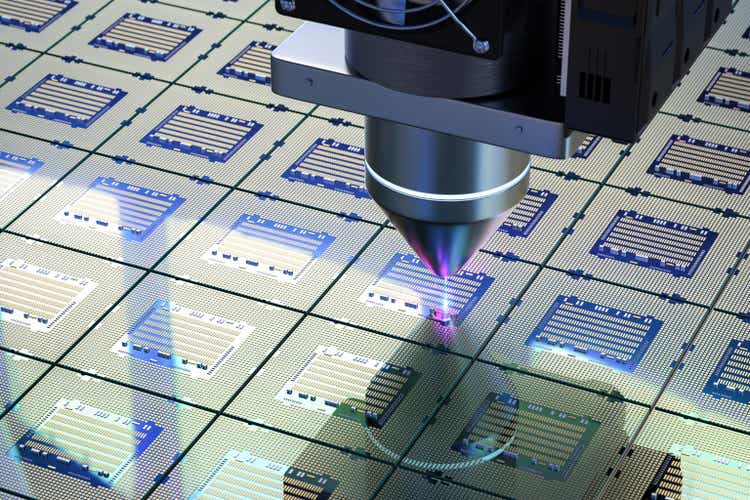PhonlamaiPhoto
BE Semiconductor (OTC:BESIY), which “develops, manufactures, markets, sells, and services semiconductor assembly equipment for the semiconductor and electronics industries worldwide,” faces downward pressure on revenue based upon declining demand after a couple of years of increasing capacity in the industry, resulting in customers’ delaying orders.
This is probably going to be a significant headwind through 2023, depending on the rebound in demand, and also on whether or not economic conditions worsen, and if they do, to what depth.
There is no doubt BESIY is going to continue to experience a decline in revenue, but the good news is its gross margin is going remain high, primarily on favorable product mix; the company will continue to throw off significant cash flow even as sales decline.
In this article we’ll at its recent numbers from its third quarter earnings report of 2022, and what to expect from the company over the next year or so.
Latest earnings
Revenue in the third quarter came in at €168.8 million, down 19 percent year-over year. Orders for the quarter dropped to €125.3 million, falling 18.2 percent sequentially. The plunge in orders was attributed to weakening market conditions as well as a decline in demand for IDM computer applications, along with lower demand from Taiwanese subcontractors.
In the fourth quarter of 2022, the company projects revenue will further drop in a range of 15 percent to 25 percent down from the revenue generated in the third quarter of 2022.
Net income of €57.3 was lower by 24.2 percent from the prior quarter, confirming the continual slowdown in demand in the semiconductor sector. GAAP earnings per share in the reporting period was €0.69.
Concerning gross margin, expectations are it’ll continue to be in a range of 60 percent to 62 percent, based upon the product mix the company anticipates in the near term, along the flexibility inherent in its production model.
In regard to operating expenses, they’re projected to climb by about 50 percent in the fourth quarter, mostly from an increase in R&D spend.
While the backlog of BESIY was higher than normal historical levels, it was still down by 12.6 percent sequentially.
At the time of its earnings release, management guided for full-year revenue to be at about €720 million, down by about 4 percent from full-year 2021. That confirms how quickly the bottom has dropped out of demand after a stronger early start to calendar 2022.
Cash flow strength
Gross margin and cash flow remain a key strength of the company, and that has contributed to a strong liquidity position for the company, even with the demand headwinds it faces.
For the first nine months of 2022, BESIY has generated €185.2 of cash flow, resulting in cash and net deposits of €661.8 million, up 12.1 percent from the third quarter of 2021, and net cash of €342.5 million, an increase of 19 percent year-over-year.
When considering the drop in revenue, it’s a good performance from the company, and that should continue in the quarters ahead, assuming a similar product mix that lends itself to gross margin at 60 percent and above, or close to it.
Supply chain diversification
When the impact of COVID hit the supply chain of BESIY, it forced the company evaluate the situation in order to reduce the risks associated with over reliance on any one supplier.
The result was for the company to be more “directly engaged” in its supply chain because of major issues emerging every day, and also because of its need to diversify its supplier base with qualified suppliers and components.
How that has improved the company by getting a “tighter grip on the supply chain” is to lower costs on a consistent basis while improving flexibility.
While that helps the company in the moment, it’s also easy to see how that will contribute to reliability and consistency once demand in the semiconductor sector increases in the future.
Conclusion
It is very clear that BESIY revenue will remain under pressure for the foreseeable future. That comes from over capacity, supply chain issues, and declining demand. It’ll take some time to work out, but because of the company’s robust gross margin, at this time it’s not likely to have a dramatic impact on earnings and cash flow, which will provide flexibility and support for investing in R&D while returning cash to shareholders.
For investors interested in doing further research on BE Semiconductor, it should be understood that it’s a very illiquid stock that trades on the OTC. Even a relatively small position a retail investor would take could be difficult to sell if there is a want or need to quickly exit the position.
In the big picture, there isn’t a lot to like in the short term for BESIY, considering it has recently bounced off its 52-week low of $38.1, and is trading at a hefty $63.85. I can see no reason to enter or add to a position until the share price corrects, as based upon guidance and falling demand, there aren’t any significant catalysts that can justify the idea the company has more room to move to the upside.
Getting caught underwater in a stock that has low liquidity isn’t a good position to be in, especially in light of an industry under pressure in regard to oversupply and falling demand.
Cash flow should continue to do well for the company, but even with gross margin that is expected to hold, it’s still going to be in relationship to declining revenue. For that reason, again, it’s best in my opinion to wait for the share price to correct before thinking in terms of investing in the stock.


Be the first to comment